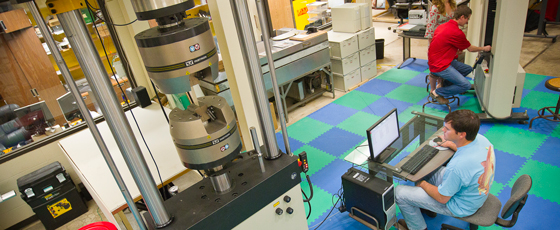Research
Faculty in the Department of Civil and Environmental Engineering maintain an active, funded research program that supports both undergraduate and graduate students.
Faculty currently are engaged in research funded by the National Science Foundation, U.S. Department of Energy, National Oceanic and Atmospheric Administration, Texas General Land Office, Texas Water Development Board and other regional agencies.
In addition, faculty have obtained competitive grants from the Center for Resiliency, Center for Midstream Management and other research entities on campus.

Current Research Activities
Consistent with the mission of the university, faculty research focuses on understanding and improving the quality of life in Southeast Texas. Current research activities focus on the following:
- Sensor Health Monitoring
- Big Data Analytics for Flood Management
- Climate Extremes in Humid Coastal Areas
- Subsidence and other geohazards in Southeast Texas
- Marine transportation
Lab Facilities
Learn about some of our laboratory facilities:
Examples of Research Projects
- Characterization of Ultraviolet Quenching Substances
In recent years, multiple municipal solid waste landfills are experiencing elevated temperature events (ETLF). It has been demonstrated that the UV quenching of leachates and gas condensates is significantly different from the previously studied ones.
The project is to investigate the UV quenching characteristics of ETLF leachates and gas well liquids that can lead to cost-effective management strategy and, more importantly, provide evidence and better understanding of the cause and mechanism of ETLFs. This project is partially funded by Waste Management National Service, Inc. More about this project.
- Development of an Algal-based Landfill Leachate Treatment System
The proposed research will develop an algal-based on-site bioremediation pathway to treat leachate. In addition to the nutrient removal, algal biomass produced from this system can be used for biofuel production, value-added bioproducts, and livestock feed supplements. Successful implementation of the proposed system will reduce the current leachate treatment costs and will provide an avenue for supplemental revenue from the produced algal biomass. Learn more about this project.
- Economic Benefits of Climate-Informed Adaptation Measures to Reduce Flood Risk
Communities along the Texas coast are exposed to the triple threats of storm surge, rainfall-driven flooding, and a rising sea level. Among the most vulnerable infrastructures are the water supply and wastewater treatment systems. During Hurricane Harvey, a number of water supply and wastewater treatment systems and services were disrupted, nearly disrupted, or severely damaged. These include those serving the City of Beaumont and mid-lower Jefferson County that are critical to the operation of energy and health care industries.
The disruptions, together with the release of untreated sewage, compounded the flood-induced devastation to buildings and transportation infrastructures, and exacerbated the stress imposed on the communities. In addition, water quality problems lingered on after flooding which significantly increased the overhead of water supply, and put strain on recovery. Therefore, there is a critical need to assess the flooding risk of water infrastructures under a changing climate, and to develop plans to retrofit, upgrade or relocate them to lower their risk profile. Learn more about this project.
- Implementation of Proactive Traffic Signal Control System at Multiple Intersections
This project aims to implement the proactive signal control system proposed in Project 0-6920 to 30 intersections, located in five arterial corridors in the Houston Metropolitan Area. Learn more about this project.
- Methods for Investigating Pervious Concrete Resistance to Calcium and Magnesium Chloride Deicers
Pervious concrete pavement is a highly permeable form of concrete which allows stormwater to permeate through the surface layer to an underground aggregate storage bed and be detained and/or infiltrated into the soil beneath. Benefits include reduced flooding and ponding, stormwater quality improvements, etc. Some deicing salts can have negative impacts on the pervious concrete layer. The objectives of these studies are the initial development of simple testing methods that others can use to compare various mix designs or treatments to pervious concrete to determine which options might be more resistant to deicer deterioration. Learn more about this project.
- Proactive Traffic Signal Timing and Coordination for Congestion Mitigation on Arterial Roads
In this project, a proactive signal control system was developed to maximize the network performance and minimize road congestion in the vicinities of intersections. Learn more about this project.
- Utility Factor of Plug-in Hybrid Vehicles Using Longitudinal GPS Data with Spatial Information
This project estimated the utility factor (UF) of plug in hybrid electric vehicles (PHEVs), using spatial, longitudinal travel data of 415 vehicles over 3-18 months in the Seattle metropolitan area, and compared the results with those from the existing research based on the National Household Travel Survey (NHTS) data. Learn more about this project.